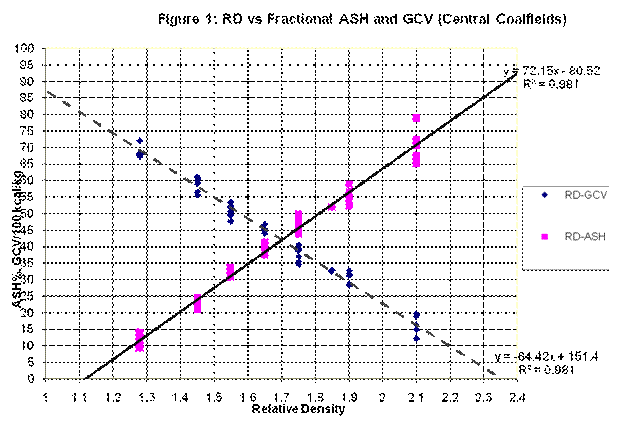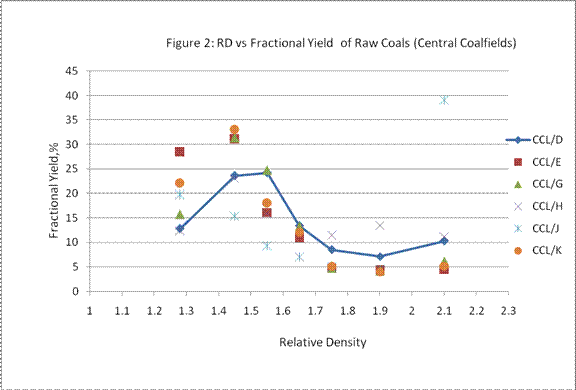kalyansen.com
dr kalyan sen
GCV-A Guide to Optimum Washing of power coals
Chandan Das*, B.E, M.E and Dr Kalyan Sen**, B.E, Dr Sc Tech
Abstract
About 70% coal produced in India is consumed in thermal power plants. Most of the plants have state-of-the-art technologies to burn pulverized coal in large furnaces. Even though the ash content of coal is relatively high, it has been seen they are burnt in raw state, in over sized boilers, as business as usual. It is now an accepted fact that the high ash raw coal should be optimally prepared to produce desired quality washed coal consistently, so as to improve efficiency of combustion, reduce fly ash generation, reduce long distance transportation cost, etc.
It has been proposed here to help in optimum designing of power plant boilers by specifying the desired GCV of the washed coal. Again, as coal is a heterogeneous substance, instead of fixing the overall quality of the washed coal, it has been thought prudent by the authors to limit the minimum GCV content (characteristic at the cut point) of the worst particles contained in the pack of washed coal, which are apprehended to have the poorest combustion properties. If the boiler can be designed suitable for that critical lowest GCV and, simultaneously, highest (characteristic) ash particle, then all other better quality particles contained in the washed coal will take care of themselves, and burn more efficiently. In this way, more than one coals of different washability properties can also be optimally prepared, so as to produce maximum yield of cleans at the desired quality.
An example considering a few coals of Central Coalfields prove that the concept of optimizing coal washing by GCV parameter can improve the efficiency of combustion, produce maximum yield of washed coal and help in better overall economy of the coal industry.
Introduction
About 70% coal produced in India is consumed in thermal power plants. Most of the plants have state-of-the-art technology to burn pulverized coal in large furnaces. Coal is ground to ultra-fine particles (below 50 micron) and fed into the plants as a solid-gas mixture with primary air and beefed up with secondary air. The combustion is more or less efficient, even though the ash content is relatively high. It has been seen that high ash Indian non-coking coals of Permian era, containing rather high Volatile Matter, burn efficiently and loose even less than 1% un-burnt carbon in the fly ash. But, if the coal contains large amount of stones and obvious dirt, loss of sensible heat through the ash particulates becomes more, besides problems in coal handling, including crushing, grinding, ash handling, etc. The amount of fly ash production has also become alarming as the ash content in raw coal in general is very high and frequently exceeds 34%, limit stipulated by the Ministry of Environment for long distance power houses. In some cases it is even more than 50%, which affects the overall performance of coal utilization and is against the clean coal technologies.
Raw coal is a heterogeneous substance. When we talk about a coal to have such and such property, we understand that it is the average property of all discrete particles. In fact, the property of individual particles can vary widely e.g. ash content of individual particles can vary from 2 to 80% while the algebraic average may be 34%. It is known that any down stream chemical process like combustion or carbonization depends on the reactivity of individual particles on an above that on the average value. In fact, preparation of coal endeavors to reduce the variability and thereby improving the homogeneity by discarding the stones and other obvious dirts. |
Thus, preparation of washed coal to suit the power houses is of utmost importance to the coal suppliers. The consistency of quality is also important as most of the power plants do not have / use blending bunkers in their storage stockpiles.
India is fortunate to have large deposits of coals having optimum maturity and petrological compositions suitable for combustion and they generally contain low Sulphur, Mercury, Nitrogen and Chloride, etc. But the necessity of economical preparation of washed coal of consistent quality need not be over emphasized.
Gross Calorific Value of Coals
Gross calorific value of coal depends upon its chemical composition, which is governed by geological environment during its coalification process, mainly on its maturity. The combustible elements present in coal like Carbon, Hydrogen, Sulphur, etc contribute to its fuel value, whereas mineral contents, both inherent and exogenous, like Silica, Iron, Aluminum, Calcium, Magnesium (generally in oxide forms), etc. are diluents to its fuel value. Moreover, the higher ash content causes loss of effective calorific value of coal by a significant amount, which depends also on the methodology of combustion.
It has been observed by studying a large number of data at CFRI, that there exists a close relation between ash content vs Gross Calorific Value (GCV) of coal. For Central Coalfield (CC) coals, as shown by the trend in Figure 1, the GCV at “zero” ash (pure) coal varies from 7000 to 8000 kcal/kg, av. being 7800 kcal/kg of the data considered here. At the same time, it was also observed that the trend of GCV becomes “zero” (completely inert) at very high ash content i.e. about 80 to 90%, av. being 88%. It is also proved that both ash and GCV contents are related to the Relative Density (RD) of coal, R2 value being 0.981. Thus, as shown in the following Figure 1, the R.D. of “zero” ash CC coal is about 1.12 (varying from 1.1 to 1.2), and R.D. of coal where GCV becomes more or less “zero” is about 2.35 (varying from 2.25 to 2.4). This is because both ash and GCV are algebraic parameters depending on the R.D, that indicates the proportion of “pure” coaly matter and “pure” mineral matters and covers all intermediate values.

Coals from other coalfields may also have similar but different values, which mainly depend on its maturity and associated mineral matters. As CC coals are both coking and non-coking in nature, the variations are significant. More matured coals, having higher Carbon % in the pure coal (ultimate analysis on dmmf basis) will have higher GCV values at any given RD or ash content. The variation in GCV can be as high as 1000 kcal/kg and the variation of ash content is as high as 10% between coking and non-coking coals at any given R.D.
Requirement of Coal for Thermal Power Plants of Desired GCV
All power plants are designed to burn coal of preferred GCV, which can be varied within certain limits. As the combustibility of coal depends mainly upon its GCV, besides granular size and furnace operational parameters, it is possible to limit the worst particle (having lowest GCV) in washed coal, which will guarantee that all other particles having higher GCV and consequently better combustibility characteristics, will burn more efficiently. This concept of optimizing coal washing process is proposed here, where minimum GCV of particulates is assured at the highest possible yield of cleans. Therefore, by the above strategy, it is possible to predict the RD of cut required to produce the desired quality of washed coal. 
The above conclusion is very important from the point of view of coal preparation, where most of the effective processes depend on gravity washing like Jig, H.M. Bath and Cyclone, etc. Barrels and Spirals also depend on Gravity Techniques to a large extent. Thus, it is suggested here, for the first time, to optimize the quality of washed coal to be supplied to a specific type of boilers by its GCV. However, the actual yield of cleans will depend upon the washability characteristics of each individual coal. Figure 2 depicts the fractional yield between the lower and upper RDs. It may be pointed out that the relation is random and can vary from seam to seam, location to location and day to day production.
In the present case, the expected GCV, Ash and Yield of cumulative cleans are shown in Figure3. If we want to limit the minimum GCV of individual particles to about 3000 kcal/kg, the corresponding characteristic ash will become about 55% and RD of cut is predicted to be 1.875. The cumulative GCV and ash content of the theoretical cleans will be about 5200 kcal/kg and 30% respectively, with a cumulative yield of around 85%. The actual cumulative yield of cleans and their quality will depend upon the raw coal supplied from day to day and efficiency of washing.

Conclusion
The criterion for optimization of coal washing process suggested here is to limit the GCV content of washed coal down to such a level that the worst coal particle included in it will be limited by the ability of the given furnace to burn it effectively. It is expected that if the worst particle can be effectively burnt in a given system of combustion, all better quality particles can be used up at ease. Thus, in the above case, if we want to restrict the limiting GCV of particles to about 3000 kcal/kg, the corresponding characteristic ash will become about 55% and RD of cut is predicted to be 1.875. The cumulative GCV and ash contents of the theoretical clean will be about 5200 kcal/kg and 30% respectively with a cumulative yield of around 85%.
The actual cumulative yield of cleans and their quality will depend upon the raw coal supplied from day to day and efficiency of washing.